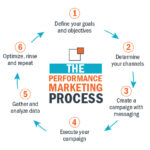- December 1, 2025
- by
- Marketing
- 0 Comments

In the digital marketing universe, Google Ads stands as one of the most powerful tools for businesses looking to boost performance marketing efforts. With billions of searches happening every day, it provides unmatched opportunities to connect with your audience at the right time. Whether you’re a small startup, a medium-sized enterprise, or a large corporation, Google Ads offers tailored solutions to drive results and maximize your return on investment (ROI).
Here’s how you can leverage Google Ads to create a performance marketing strategy that delivers success, broken down in a way anyone can understand.
What is Google Ads and Why Should You Care?
Google Ads is an online advertising platform where businesses pay to display their ads on Google’s search engine results pages (SERPs), YouTube, and other websites within the Google Display Network.
Why use it?
Massive Reach: Google processes over 3.5 billion searches daily.
Measurable Results: Track every click, impression, and conversion.
Flexibility: Suitable for any budget, from local cafes to global giants.
Audience Targeting: Zero in on your ideal customer using demographic, geographic, and behavioral data.
Step-by-Step Guide to Leveraging Google Ads
Set Clear Campaign Goals
Your first step is to define what you want to achieve. Different goals require different strategies:
Small Businesses: Drive local store visits or online traffic.
Medium Enterprises: Focus on generating leads and increasing brand awareness.
Large Corporations: Optimize for large-scale sales and customer retention.
Pro Tip: Use Google Ads’ campaign types like Search Ads for high-intent users or Display Ads for brand visibility.
Understand Your Target Audience
Knowing who you’re speaking to is critical. Google Ads offers tools to help you segment and target your audience based on:
Age, gender, income levels.
Location, language.
Interests, buying habits.
For example:
A local bakery can target “people near me” searching for birthday cakes.
A software company can target IT professionals browsing for SaaS tools.
Choose the Right Keywords
Keywords are the backbone of Google Ads. They ensure your ad appears when users search for terms relevant to your business.
Steps to Get it Right:
Use Google Keyword Planner to find high-traffic keywords.
Focus on long-tail keywords (e.g., “affordable wedding photographers in Delhi”) to attract specific audiences.
Avoid wasting money on irrelevant clicks by adding negative keywords.
Optimize Your Ad Copy
Your ad copy needs to grab attention and compel action in just a few words. Follow these tips:
Include the keyword in your headline to match user intent.
Highlight your unique selling proposition (USP).
Add a call-to-action (CTA): Examples include “Shop Now,” “Get a Free Quote,” or “Download the App.”
Example:
Searching for “eco-friendly water bottles”? An ideal ad could be:
“Stay Hydrated, Save the Planet | Eco-Friendly Bottles Starting at ₹299. Shop Now!”
Build Landing Pages That Convert
Your ads are only half the equation—where they lead matters just as much. Your landing page should:
Be fast and mobile-friendly.
Match the tone and message of the ad.
Include a clear CTA (e.g., “Sign Up Today” or “Buy Now”).
Pro Tip: Use tools like Google Optimize to test different versions of your landing page.
Set and Manage Your Budget Wisely
Google Ads lets you control your spending, making it suitable for businesses of all sizes.
Small Businesses: Start with a daily budget as low as ₹500. Focus on pay-per-click (PPC) campaigns for cost-efficiency.
Medium Enterprises: Allocate more for display and video ads to expand reach.
Large Corporations: Invest in dynamic campaigns like Shopping Ads or Performance Max for global visibility.
Pro Tip: Use Smart Bidding to let Google’s AI optimize bids for maximum conversions.
Measure Performance and Optimize
The beauty of Google Ads lies in its measurability. Tools like Google Analytics and Google Ads Dashboard provide data on:
Impressions and clicks.
Conversion rates and cost per conversion.
Keyword performance.
How to Improve Over Time:
Identify underperforming keywords and pause them.
Test different ad creatives with A/B testing.
Adjust bids for high-converting keywords.
Real-Life Examples: Success with Google Ads
Small Business Example:
A boutique flower shop increased local orders by 60% in three months by targeting “florists near me” keywords and running Google Maps ads.
Medium Enterprise Example:
A fitness equipment brand doubled its leads using Shopping Ads and retargeting campaigns on YouTube.
Large Corporation Example:
A global e-commerce brand reduced its cost per acquisition (CPA) by 30% using Google’s AI-powered Performance Max campaigns.
Why Google Ads is Worth the Investment for All Business Sizes
For Small Businesses: It’s a cost-effective way to generate leads and build brand awareness.
For Medium Enterprises: It scales your marketing efforts while keeping ROI in focus.
For Large Corporations: It enhances omnichannel strategies with precision targeting and advanced analytics.
Why Choose Novus Engage for Your Google Ads Strategy?
At Novus Engage, we help businesses harness the full potential of Google Ads. Here’s how we make the difference:
Tailored Campaigns: Customized strategies for businesses of every size.
Data-Driven Insights: We use analytics to maximize ROI.
Expert Optimization: Ongoing tweaks to ensure peak performance.
Transparent Reporting: Know exactly where your money is going.
Conclusion: Take Your Marketing to the Next Level
Google Ads is the ultimate performance marketing tool for businesses of all sizes. By understanding its features, setting clear goals, and partnering with experts, you can transform your marketing efforts and achieve remarkable growth.
Ready to start your Google Ads journey? Contact Novus Engage today, and let’s create campaigns that deliver results!




